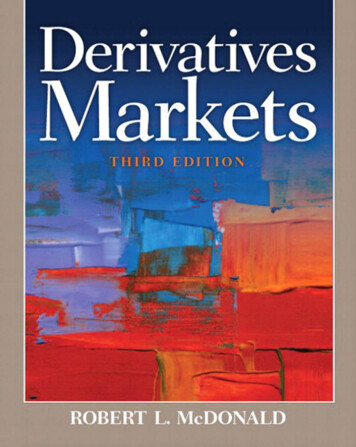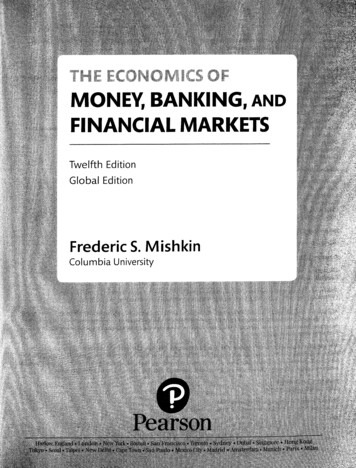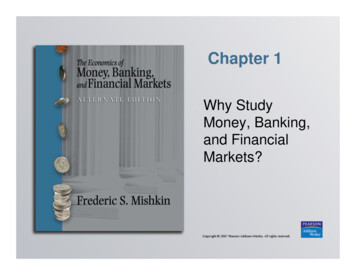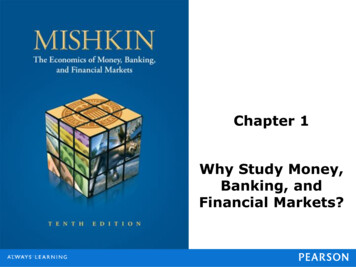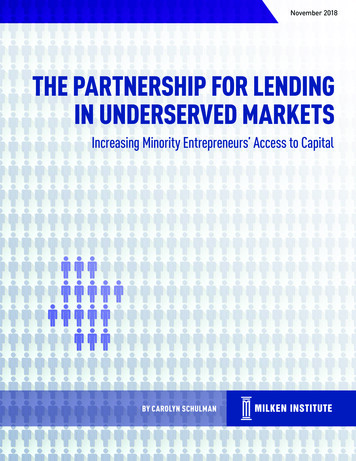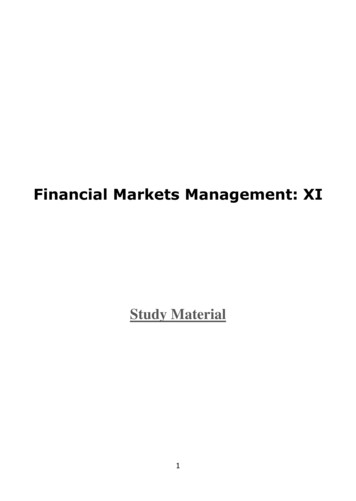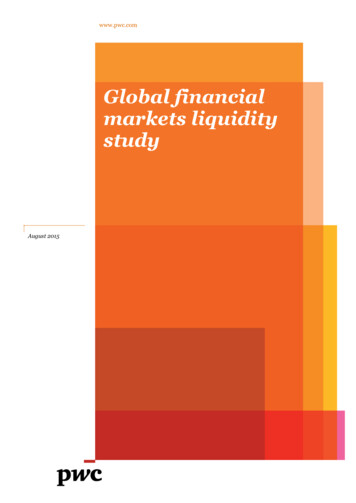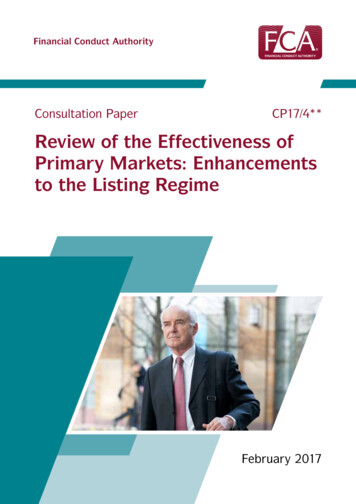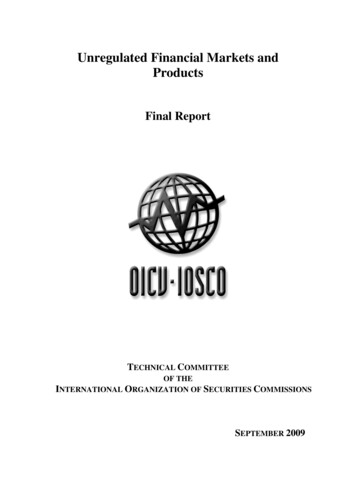
Transcription
Unregulated Financial Markets andProductsFinal ReportTECHNICAL COMMITTEEOF THEINTERNATIONAL ORGANIZATION OF SECURITIES COMMISSIONSSEPTEMBER 2009
CONTENTSChapterPageForeword2Chapter 1Overview3Chapter 2Executive summary5Chapter 3What happened?12Chapter 4What are the issues with securitisation?15Chapter 5What are the issues with credit default swaps?29Chapter 6 Can we develop general recommendations to apply more widelyto unregulated financial markets and products?41References44Annex 1 List of Participants of the Task Force on Unregulated FinancialMarkets and Products471
ForewordThe IOSCO Task Force on Unregulated Financial Markets and Products was formed insupport of G-20 calls for a review of the scope of financial markets and in particularunregulated financial markets and products.This Final Report examines ways to introduce greater transparency and oversight inunregulated financial markets and products and improve investor confidence in, and thequality of, these markets.This Final Report makes recommendations about regulatory approaches to beconsidered by financial market regulators and then implemented as appropriate withrespect to securitisation and credit default swap markets and then goes on to discuss thebroader unregulated financial markets.2
1OverviewThe Task Force on Unregulated Financial Markets and Products1This is the Final Report of IOSCO‟s Technical Committee (TC) in respect of theTask Force on Unregulated Financial Markets and Products (TFUMP) co-chairedby the Autorité des Marchés Financiers (AMF) of France and the AustralianSecurities and Investments Commission (ASIC) of Australia.12This Final Report follows a consultation report published on 5 May 2009 andindustry consultation.2 TFUMP recognises the valuable input of industryparticipants to the finalisation of this Final Report.3IOSCO initiated TFUMP in support of The Group of Twenty (G-20) calls for areview of the scope of financial regulation with “a special emphasis oninstitutions, instruments and markets that are currently unregulated, along withensuring all systemically important institutions are appropriately regulated”.34Consequently, IOSCO announced on 25 November 2008, in support of these G-20aims, that:45(a)the TC's program to address the continuing market turmoil would focus onstrengthening financial markets and investor protections; and(b)TFUMP would examine ways to introduce greater transparency and oversightto unregulated market segments, such as over-the-counter (OTC) markets forderivatives and other structured financial products.The G-20 has subsequently reinforced the importance of the work of TFUMP,recommending that all systemically important financial markets and instrumentsshould be subject to an appropriate degree of regulation and oversight,consistently applied and proportionate to their local and global significance.5TFUMP's mandate6TFUMP has approached its mandate by acknowledging industry initiatives and inaddition, recommending regulatory action designed to improve confidence incurrently unregulated financial markets and products by promoting fair, efficientand orderly markets. These steps are important to the recovery of theinternational financial system.1Members of TFUMP include regulators from: Brazil, Germany, Hong Kong, Italy, Japan,Mexico, the Netherlands, Quebec, Spain, the United Kingdom and the United States of America.2Consultation Report of the Task Force on Unregulated Financial Markets and Products, 5 May2009, 0.pdf.3Declaration on the Summit of Financial Markets and the World Economy, G20 Communiqué, 15November 2008, available at http://www.g20.org/Documents/g20 summit declaration.pdf.4IOSCO Technical Committee Launches Task Forces to Support G-20 Aims, IOSCO osco.org/news/pdf/IOSCONEWS134.pdf.5Final Report of the G20 Working Group 1 Enhancing Sound regulation and StrengtheningTransparency, 25 March 2009, Recommendation 5, pgs 6 to 10.3
7While the term „unregulated financial markets and products‟ describes differentmarkets and products depending on the particular jurisdiction in question,TFUMP has focused on systemically important markets and products that havefeatured prominently in the global financial crisis and are relevant to therestoration of confidence in international financial markets.68The overall objective of TFUMP is, consistent with the aims of the G-20, torecommend ways to redefine the perimeter of regulation and the scope ofintervention by regulators. As the recommendations of this Final Report gobeyond the traditional remits of regulators, further work is required and indeed isbeing undertaken by IOSCO to identify the appropriate criteria to be used toredefine the border between what has traditionally been considered regulated andunregulated.9This Final Report identifies in general terms possible areas for initial andimmediate regulatory actions that could be undertaken within the context of thecurrent market situation. The analysis does not expand on the broader systemicrisks surrounding the unregulated financial markets and products sector and themeans to mitigate any such risk.10In its work, TFUMP has had regard initially to two systemically importantmarkets, securitisation and credit default swaps (CDS). The recommendationscontained in this Final Report are intended to address issues of immediate concernwith respect to: (i) securitised products, including asset-backed securities (ABS),asset-backed commercial paper (ABCP) and structured credit products such ascollateralised debt obligations (CDOs), synthetic CDOs and collateralised loanobligations (CLOs); and (ii) CDS, and are targeted at encouraging confidentparticipation of investors in unregulated financial product and market sectors.11On the basis of the recommendations identified for these markets, this FinalReport identifies the need for further consideration of other OTC derivativesmarkets. However, the potential development of recommendations regarding othersegments of OTC derivatives markets should not delay the consideration,finalisation and implementation by financial market regulators of anyrecommendations relating to securitisation and CDS in this Final Report.6These markets and products may already be regulated in some jurisdictions.4
2Executive summaryComplexity of issues, but need to recognise contribution regulation can play12The global financial crisis has not yet run its full course. Regardless, much hasalready been written about its causes with most analysts agreeing that the causesare complex, and are the culmination of years of economic and social policychoices.13Acknowledging the complexity of the issues involved, this Final Report hasidentified some areas where regulation could play an important role in restoringconfidence to international financial markets. The recommendations made areaimed at supporting investor confidence in these markets and at improving thefunctioning, integrity and oversight of unregulated financial markets and products.14The recommendations referred to in this Final Report were developed by initiallyexamining the securitisation and CDS markets.15Why securitisation and CDS?(a)These markets are critically important to the availability of credit and therestoration of international capital flows;(b)These markets are international; and(c)The examples illustrate different concerns. Securitisation issues relate tosecondary market transparency, initial and ongoing disclosure, duediligence,7 conflicts of interests, incentives and investor suitability. CDS arebilateral contracts designed for credit hedging or speculative investment andissues relate to counterparty risk, operational risk and market transparency.16In proposing recommendations, TFUMP acknowledges and encourages industryinitiatives to strengthen the operation of the securitisation and CDS markets, butrecognises that industry initiatives have limits. Participation is typically voluntaryand the standards lack regulatory status and consistent implementation.Moreover, neither industry initiatives nor market discipline averted thedeficiencies that contributed to the global financial crisis. Accordingly, theseinitiatives should, where appropriate, be supplemented and supported byregulation.17Given the focus of this Final Report and the need for immediate action, TFUMPhas not considered the broader macro-economic policy issues surrounding thesecuritisation and CDS markets such as whether the „originate to distribute model‟and trading in OTC CDS have increased systemic risk and made the financialsystem more unstable and if so, whether more fundamental changes are required.7TFUMP notes that the use of "due diligence" in this context does not refer to any statutorydefences in respect of inadequate disclosure that may be available in certain jurisdictions. Forexample, were the term "due diligence" is used in this Final Report this is not a reference to anydue diligence defence available under the US Securities Act (1933). The availability and scopeof such defences is not within the scope of this Final Report.5
Recommended regulatory changes for securitisation and credit defaultswaps markets18Analysis of these markets has identified a number of potential improvements inregulatory oversight that would assist in restoring investor confidence andimprove market quality. This analysis has been informed by the wealth ofcommentary and analysis on these sectors produced in other forums.8 It has alsobeen assisted by the industry consultation in respect of the consultation report.19A summary of the recommendations for securitisation is set out at the end ofChapter 4 of this Final Report. A summary of the recommendations for CDS isset out at the end of Chapter 5 of this Final Report.Implementation of Recommendations20Giving due consideration to the roadmap of the G-20 (including the G-20Working Group on Enhancing Sound Regulation and StrengtheningTransparency) and the most recent communiqué from the G-20 London Summit,9IOSCO will continue to consider recommendations and further work for specificOTC markets to complement certain recommendations in this Report and in theinterest of promoting greater regulatory convergence among its members. Anumber of the respondents to the consultation paper published in May 2009 werein favour of additional work being done by IOSCO to promote convergence and alevel playing field between jurisdictions.21TFUMP acknowledges the work already done by international associations ofmarket professionals in response to the crisis and to help restore the functioning ofthe market and will reflect on the appropriate manner to obtain input fromindustry going forward.22However, TFUMP recognises that financial market regulators may consider anumber of different regulatory responses in seeking to implement therecommendations in their respective jurisdictions. These responses may include,working with industry bodies to encourage behavioural change, recommendingcompliance with industry codes of best practice, issuing regulatory guidance,formal rulemaking and recommending legislative action.Discussion of possible general recommendations that may be drawn23The analysis of the CDS markets may be used to inform further analysis byIOSCO in relation to other unregulated OTC derivatives markets.24A discussion of standardised10 and non-standardised OTC derivative products canbe found in Chapter 6.8See References at the end of this Final Report.9A copy of the G20 communiqué from the London Summit may be obtained fromhttp://www.g20.org/Documents/g20 communique 020409.pdf10Standardised to the extent they can be accepted by a central counterparty (CCP) (i.e., CCPeligible). A CCP is a clearing house that interposes itself between the counterparties to atransaction in order to assume their rights and obligations, acting as the buyer to every seller andthe seller to every buyer.6
What is not covered and why25This Final Report has focused on measures that can be taken immediately tosupport confidence in, and promote the fairness, efficiency, and orderliness of,international financial markets, informed by recent experiences.26TFUMP is aware that commentary suggests that other parameters also needreview:Table 1: Commentary on other issues not addressed in this Final ReportIssueReportsPrudential standardsapplicable to the issue of, orinvestment in, unregulatedfinancial markets andproductsFSF, Report of the Financial Stability Forum on EnhancingMarket and Institutional Resilience, 7 April 2008FSF, Report of the Financial Stability Forum on EnhancingMarket and Institutional Resilience – Follow up onImplementation, 10 October 2008FSF, Report of the Financial Stability Forum on EnhancingMarket and Institutional Resilience – Update onImplementation, 2 April 2009FSF, Report of the Financial Stability Forum on AddressingProcyclicality in the Financial System, 2 April 2009Joint FSF-BCBS Working Group on Bank Capital Issues,Reducing procyclicality arising from the bank capitalframework, March 2009Joint FSF-CGFS Working Group, The role of valuation andleverage in procyclicality, March 2009Group of Thirty, Financial reform: A Framework forFinancial Stability, 15 January 2009IOSCO Technical Committee, Report on the SubprimeCrisis, May 2008, pp16-19Bank for International Settlements, Guidelines forcomputing capital for incremental risk in the trading book –final version, Basel Committee on Banking Supervision,July 2009Bank for International Settlements, Revisions to the Basel IImarket risk framework – final version, Basel Committee onBanking Supervision, July 20097
IssueReportsBank for International Settlements, Enhancements to theBasel II framework, Basel Committee on BankingSupervision, July 2009Accounting treatment andaccounting valuation ofunregulated productsBank for International Settlements, Fair value measurementand modelling: an assessment of challenges and lessonslearned from the market stress, Basel Committee on BankingSupervision, June 2008Senior Supervisors Group, Observations on RiskManagement Practices during the Recent MarketTurbulence, 6 March 2008IOSCO Technical Committee, Report on the SubprimeCrisis, May 2008, pp14-16FSF, Report of the FSF Working Group on Provisioning,March 2009Joint FSF-CGFS Working Group, The role of valuation andleverage in procyclicality, March 2009Financial Crisis Advisory Group, Report of the FinancialCrisis Advisory Group, 28 July 2009Conduct of hedge funds inunregulated financialmarkets and productsBank for International Settlements, Credit Risk Transfer:Developments from 2005 to 2007, The Joint Forum, July2008IOSCO Technical Committee, Hedge Funds Oversight FinalReport, June 200927Consideration should also be given to recommendations by other working groupssuch as the G-20 working group on Enhancing Sound Regulation andStrengthening Transparency.IOSCO's Technical Committee Standing Committees2811Existing IOSCO Standing Committees11 and Task Force mandates also coveraspects of issues that relate to unregulated financial markets and products.Generally, the recommendations made in this Final Report do not extend to issuesbeing considered by the IOSCO Standing Committees.The TC Standing Committees are Multinational Disclosure and Accounting (TCSC1),Regulation of Secondary Markets (TCSC2), Regulation of Market Intermediaries (TCSC3),Enforcement and Exchange of Information (TCSC4), and Investment Management (TCSC5). InJune 2009, IOSCO converted the Task Force on CRAs into Standing Committee 6 on CRAs(TCSC6).8
29The relevant IOSCO Standing Committees and Task Force mandates are:Table 2: IOSCO’s Technical Committee Standing Committees and Task ForcemandatesIOSCO EntityMandateTechnicalCommitteeStandingCommittee 1 onMultinationalDisclosure andAccounting(TCSC1)Issuer Transparency and Investor Due Diligence Consult with market participants regarding typical structures anddisclosure practices (including disclosure practices for the risksassociated with underlying assets) for private placements of ABS;compare to disclosure requirements pertaining to public offerings andtrading of ABS Review IOSCO issuer disclosure standards and principles reapplicability to public issuance of ABS Develop principles regarding disclosure requirements for publicofferings of ABS if existing standards and principles are inapplicableto such offerings Review degree to which existing internal controls and due diligencedocumentation procedures regarding the ownership rights attached tothe assets underlying publicly traded securitised products protect theinterests of investors in these productsFirm Risk Management and Prudential Supervision Consider whether additional guidance and disclosure relating to offbalance sheet entities would be valuable to investors; TCSC1 willprovide input to IASB in conjunction with its work in this area during2008-2009Valuation Consider whether additional guidance and disclosure related tomeasurement at fair value would be valuable in meeting the needs ofinvestors; TCSC1 will provide input to the IASB in conjunction withits work in this area during 2008-2009TechnicalCommitteeStandingCommittee 2 onRegulation ofSecondaryMarkets(TCSC2)Post-Trade Transparency for Structured Finance Products With input from the financial service industry, examine the viability ofa secondary market reporting system for different types of structuredfinance products, focusing on whether the nature of structured financeproducts lends itself to such reporting and the costs and benefits ofsuch a system9
IOSCO EntityMandateTechnicalCommitteeStandingCommittee 3 onRegulation ofMarketIntermediaries(TCSC3)Firm Risk Management and Prudential Supervision Review best practices developed by originators and sponsors re duediligence and risk management practices for assets originated fortransfer off their balance sheets. Report to TC on TCSC3‟s opinion ofadequacy of these best practices Monitor work and review any report of the Senior Supervisors Groupon firm risk management and determine further work warranted byIOSCO Survey members‟ experience on liquidity risk management andliquidity standards to assist and supplement the work being undertakenjointly with the Basel Committee on Banking Supervision Review capital charges for risks in the trading bookInvestor Suitability Investor suitability issues relating to intermediaries‟ distribution toinvestors of complex financial productsTechnicalCommitteeStandingCommittee 3 onRegulation ofMarketIntermediaries(TCSC3) &TechnicalCommitteeStandingCommittee 5 onInvestmentManagement(TCSC5)Firm Risk Management and Prudential Supervision Undertake a study of the internal control systems of financial firms,including asset managers, in different IOSCO jurisdictions anddevelop principles to address any concerns identifiedTechnicalCommitteeStandingCommittee 5 onInvestmentManagement(TCSC5)Issuer Transparency and Investor Due Diligence Review: degree that investment managers who offer collectiveinvestment schemes to retail investors have invested in structuredfinance products; type of due diligence typically conducted whenmaking these investments; degree to which these investment managershave been affected by the current market turmoil; and if and howinvestment managers have shielded retail investors from the effects oftheir exposure to losses from structured finance products and anybroader market implications such activity may haveValuation Explore whether, as a matter of internal control, registeredintermediaries and investment advisers avail themselves ofpractitioners who are skilled/trained enough to model fair valuationadequately in illiquid market conditions10
IOSCO EntityMandateTechnicalCommitteeStandingCommittee 6 onCredit RatingAgencies(CRAs)CRAs Assess the implementation of the May 2008 IOSCO CRA Code and topresent related recommendations on mechanisms for greater oversightcooperation and information sharing among regulatorsIOSCO TaskForce onImplementationof the IOSCOObjectives andPrinciples ofSecuritiesRegulation(ITF)CPSS & IOSCO Recommendations for Central Counterparties ITF has noted the need to review the CPSS & IOSCORecommendations for Central Counterparties12 in light of industrydevelopments3012TCSC1, TCSC2, TCSC3 and TCSC5 have provided input to TFUMP and theircomments are reflected in this Final Report.Recommendations for Central Counterparties, Joint Report of the Committee on Payment andSettlement Systems and the Technical Committee of IOSCO, November 2004, available D176.pdf.11
3What happened?Key causes of the global financial crisisWhat has happened in unregulated markets generally?31A combination of complex macroeconomic circumstances set the scene for theglobal financial crisis. As Claudio Borio of the Bank for International Settlements(BIS) has said, “the turmoil is best seen as a natural result of a prolonged periodof generalised and aggressive risk-taking, which happened to have the sub-primemarket at its epicentre it represents the archetypal example of financialinstability with potentially serious macroeconomic consequences that follows thebuild-up of financial imbalances in good times”.1332Most analysis points to the ultimate 'cause' of the global financial crisis being acoincidence of many years of strong, stable growth and low inflation; exchangerate and balance of payments imbalances that saw savings of many developingcountries and energy exporters transferred to more sophisticated financial systemssuch as the US and UK for investment; demographic transition creating vast poolsof retirement savings in some economies; and the inherent pro-cyclical tendenciesin finance. This resulted in financial businesses and investors taking on moregearing, bidding up asset prices and reducing risk margins to make short-termprofits. Eventually markets had gone too far, mispricing and taking on too muchrisk – sub-prime was just where the problems crystallised first.33Analyses of the failures and possible causes of the global financial crisis arenumerous. For example, reports have been produced by the IMF, the World Bank,the Financial Stability Forum, the US Senate Congressional Oversight Panel, theGroup of Thirty (G30), the G-20 and various national and financial marketregulators.34There are also a variety of regulatory and industry initiatives currently in progressbut incomplete, for example:35(a)Basel Committee capital adequacy amendments;(b)Developments relating to the OTC derivatives market, including theestablishment and use of CCPs; and(c)Aggregation of post-trade data initiatives.14In respect of the role played by OTC structured products, such as securitisedproducts and CDS, in the global financial crisis, some believe that the complexity,opaqueness and risks embedded into certain securitised products and CDS haveincreased rather than decreased systemic risk in the international financial marketsand that these concerns require a fundamental rethinking of how to structure and13Borio, Claudio, The financial turmoil of 2007-?: a preliminary assessment and some policyconsiderations, BIS Working Papers No. 251, March 2008.14For example, one initiative is that The Depository Trust and Clearing Corporation (DTCC) hasbegun publishing aggregate CDS market data from its Trade Information Warehouse.12
regulate those markets.15 Balanced against this is the view expressed by industryparticipants that, while certain types of securitised products and CDS were centralto aspects of the global financial crisis, in general, these instruments have manybenefits for the financial markets and the real economy.3637It is nevertheless worthwhile examining two key product areas – securitisationand CDS – with a view to making recommendations that regulators mayimplement to help promote transparency, market integrity and market quality.Such an analysis may assist in developing recommendations regarding regulatorychanges to other OTC derivatives markets.Why have we chosen securitisation and CDS as two examples of unregulatedmarkets?38The primary reason that TFUMP has focused on securitisation and CDS isbecause of the great significance of these markets and products to creditavailability in the real economy and their contribution to the management ofindividual and systemic risks. A second reason is that both securitisation andCDS grew rapidly in the build up to the global financial crisis and featuredprominently in the onset of the global financial crisis.39Securitisation involves packaging receivables or other financial instruments andissuing securities linked to those receivables or instruments to investors.Securitisation allows banks to move assets and liabilities off-balance sheet andfree up capital for lending and other activities. It creates competition in thelending market between banks and non-bank financiers resulting in reducedborrowing costs for consumers.40Securitisation may not be wholly unregulated in any jurisdiction and in somejurisdictions will be heavily regulated in some respects. For example, in theUnited States, disclosure requirements apply whenever an issuer makes a publicoffering, regardless of whether the securities are exchange-listed and irrespectiveof the sophistication of the investor.In other jurisdictions, disclosurerequirements may apply only when securities are listed on a regulated market oroffered to retail or „unsophisticated‟ investors. For the purposes of this FinalReport, we will discuss the whole securitisation market. Where this Final Reportmakes a recommendation regarding a product already regulated in a particularjurisdiction, that jurisdiction may wish to consider whether the aim ofrecommendation is met by their current regulatory settings.41The absence of a well-functioning securitisation market will impact consumers,banks, issuers and investors. The price of credit is likely to be higher for theconsumer and the availability scarcer. Banks will no longer have a tool to reducerisk and diversify their financing sources.42More broadly, the current absence of an efficient and smoothly functioningsecuritisation market has substantial implications for continued economic growth.15Speech by Paul Volcker at the New York Economic Club, 8 April 2008, available athttp://econclubny.org/files/Transcript Volcker April 2008.pdf; and Christopher Whalen, What is toBe Done With Credit Default Swaps, Institutional Risk Analytics, at the American EnterpriseInstitute 23 February 2009, http://www.rcwhalen.com/pdf/cds aei.pdf.13
The Global Joint Initiative16 in its report (the GJI Report)17 estimated that banksmay fail to meet US 2 trillion of demand for credit origination in the absence ofwell-functioning securitisation markets.43Similarly, the CDS market allows CDS buyers and sellers, such as banks,institutional investors, hedge funds, sovereign entities and other marketparticipants to adjust economic exposure to changes in the perceived credit risk ofa referenced obligation and related interests, and to purchase protection againstthe risk of a reference entity becoming insolvent or defaulting on a paymentobligation. The reference entity can be a single debt security or entity, including acountry (single-name reference entity) or the CDS can reference a number ofentities (CDS index). Another important function of the CDS market is that it canact as a price-discovery mechanism for the creditworthiness of the referenceentity, and can affect the price of related interests including debt and equitysecurities issued by the entity. Credit derivative spreads are also used as abenchmark for lending rates and for assessing the creditworthiness of an entityand it is therefore important that they accurately reflect the risks they are intendedto reflect. However, as noted by the recent G30 report, in addition to CDS servinga “valuable risk transfer function, a large speculative element has emerged.”18Concerns about market manipulation and insider trading have also been raised.1944Compared against each other, securitised products and CDS have different riskcharacteristics. CDS risks are linked to the swap counterparty and to theunderlying reference entity(s), while the risks of securitised products are linked tothe quality of the underlying receivables or financial instruments and the collateralwhich secures those obligations. Securitised products are also highly structuredinvolving many participants in the chain from origination to issuance, while CDSare bilateral contracts which may be standardised to an extent where they can beexchange traded and centrally cleared. CDS also pose counterparty risks thatsecuritised products generally do not. The risk profiles of securitised productsand CDS may converge in cases where CDS are written on securitised productssuch as MBS20 and CDOs.16The Global Joint Initiative is comprised of the American Securitization Forum (ASF), SecuritiesIndustry and Financial Markets Association (SIFMA), Australian Securitisation Forum (AuSF)and European Securitisation Forum (ESF).17ASF, SIFMA, AuSF, ESF, Restoring Confidence in the Securitization Markets, 3 December2008.18Group of Thirty, Financial reform: A Framework for Financial Stability, 15 January 2009, atp53.19Testimony of Erik Sirri, Director, Division of Trading and Markets, US SEC, before the HouseCommittee on Agriculture, 20 November 2008; Testimony of Chairman Christopher Cox, USSEC, before the Committee on Banking, Housing and Urban Affairs, United States Senate, 23September 2008; International Herald Tribune, US examines possible insider trading in creditdefault swaps, Bloomberg News, 25 June 2007.20Mortgage-backed securities.14
4What are the issues with securitisation?45While TFUMP has adopted the three categories used by McKinsey21 to analysethe issues with securitisation, TFUMP
support of G-20 calls for a review of the scope of financial markets and in particular unregulated financial markets and products. This Final Report examines ways to introduce greater transparency and oversight in unregulated financial markets and products and improve investor confidence in, and the quality of, these markets.

